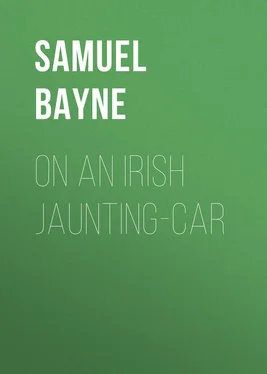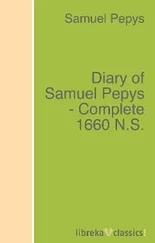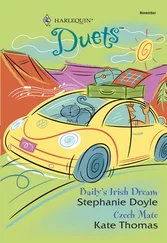Samuel Bayne - On an Irish Jaunting-car
Здесь есть возможность читать онлайн «Samuel Bayne - On an Irish Jaunting-car» — ознакомительный отрывок электронной книги совершенно бесплатно, а после прочтения отрывка купить полную версию. В некоторых случаях можно слушать аудио, скачать через торрент в формате fb2 и присутствует краткое содержание. Жанр: foreign_antique, foreign_prose, на английском языке. Описание произведения, (предисловие) а так же отзывы посетителей доступны на портале библиотеки ЛибКат.
- Название:On an Irish Jaunting-car
- Автор:
- Жанр:
- Год:неизвестен
- ISBN:нет данных
- Рейтинг книги:5 / 5. Голосов: 1
-
Избранное:Добавить в избранное
- Отзывы:
-
Ваша оценка:
- 100
- 1
- 2
- 3
- 4
- 5
On an Irish Jaunting-car: краткое содержание, описание и аннотация
Предлагаем к чтению аннотацию, описание, краткое содержание или предисловие (зависит от того, что написал сам автор книги «On an Irish Jaunting-car»). Если вы не нашли необходимую информацию о книге — напишите в комментариях, мы постараемся отыскать её.
On an Irish Jaunting-car — читать онлайн ознакомительный отрывок
Ниже представлен текст книги, разбитый по страницам. Система сохранения места последней прочитанной страницы, позволяет с удобством читать онлайн бесплатно книгу «On an Irish Jaunting-car», без необходимости каждый раз заново искать на чём Вы остановились. Поставьте закладку, и сможете в любой момент перейти на страницу, на которой закончили чтение.
Интервал:
Закладка:
We coasted the Atlantic for a few miles, and then turned into the hills that surround Mulroy Bay, which soon came into sight. When we reached the shore a council of war was held, and it was decided to save some twenty miles of driving up round the head of the bay, by crossing, if possible, at the lower end; so a broad, heavy, but unseaworthy boat was chartered, and we took Bob, the horse, out of the car and rolled the latter into the stern of our marine transport. It was no easy task to get Bob to face the water; however, after beating about the bush for half an hour, he suddenly grew tractable, and we pushed him into the boat by main strength. The passage was ludicrous in the extreme; at every high wave Bob would lash out his heels and prance. The captain of the boat (who, by the way, was an Irishwoman) would berate John for owning a horse "whose timper was so bad that he might plounge us all into etarnity without a minit's notice!" John kept whispering in a loud voice into his horse's ear promises of oats, turnips, and a bran-mash by way of dessert, if he would only behave himself. The tide was running strong, and when we were swept past our landing we each became captain in turn without appointment, and a variety of language was indulged in that would have made the Tower of Babel seem like a Quaker meeting. The farce was suddenly ended by Bob's breaking loose from his owner and jumping ashore like a chamois. We then ran the boat aground, took out the car, and, after capturing Bob with the promised oats, were soon on our way again.
In a short time after again starting, we ascended a hill and could clearly see the spot where Lord Leitrim was assassinated in April, 1878. It lay up the bay in a clump of woods, close to the water. Lord Leitrim had been very harsh with his tenants and had evicted large numbers of them from their farms; they therefore determined to "remove" him, and a select band of them lay in ambush along the road and succeeded in killing his lordship, his driver, and his secretary while they were driving to Derry. There were many trials in court, but those arrested could never be convicted. As a boy I have been more than once startled by the appearance of a pair of cars with eight men on them, each having a couple of double-barreled shotguns. Lord Leitrim was one of them; the others were his guards, going to Milford to collect the rents. His temper was so violent that the government removed him from the office of magistrate. His son, the late Earl, was a very different kind of man; he did everything within his power to advance his tenants' interests. After his death, a few years ago, the tenantry erected a fine monument to his memory in Carrigart Square. We later read the inscription upon it, which was, "He loved his people."
After a pleasant drive we reached Carrigart and had a good lunch there; we tried the Carrigart "perfectos" afterwards, and their memory clings to us still! We then started for the Rosapenna Hotel, which was not far distant – less than two miles. This hotel was built of wood, after the Scandinavian fashion, by the trustees of the late Earl of Leitrim, and opened in 1893. It was designed in Stockholm, whence the timber was shipped to Mulroy. It stands at the base of Ganiamore Mountain, on the narrow neck of the Rossgull peninsula, between Mulroy Bay and Sheephaven. Fine golf links have been laid out with eighteen holes, the circuit being three miles and a half. For visitors there is excellent fishing in the adjacent waters, by permission of the Countess of Leitrim, and good bathing on the strands of Sheephaven, which afford a smooth promenade of six miles. From the top of Ganiamore a good view is obtained of the coast from Horn Head round to Inishowen peninsula, and from its hills a fine sweep inland to Errigal Mountain. At Downing's Bay there is one of the finest views in Donegal, looking up and down Sheephaven, the woods of Ards and the tower of Doe Castle backed up in the distance by the ponderous mass of Muckish. Within a short distance of the hotel are three caves which can be entered, one from the brow of the hill and the others at low water. Near it also is Mulroy House, the residence of the Countess of Leitrim.
From Rosapenna we drove to Doe Castle, built on the shores of Sheephaven. This was a stronghold of the McSweenys, which has been, to a certain extent, modernized and rendered habitable by a late owner, who in doing so pulled down some of the walls. It consists of a lofty keep with massive walls, which enclose passages and stone stairs. It is surrounded by a "bawn," or castle-yard, defended by a high wall, with round towers at intervals. The rock on which it stands is not very high, but from its almost insulated position it was difficult to approach. It was garrisoned by Captain Vaughan for Queen Elizabeth, but was betrayed to the followers of Sir Cahir O'Doherty. It was besieged in 1608, and Davis says: "Being the strongest in Tyrconnell, it endured one hundred blows of the demi-cannon before it surrendered."
A little to the north, but separated by a prolongation of the marsh at the head of Sheephaven, is Ards House, owned by Alexander J. R. Stewart. This demesne is fenced with a cut-stone wall which we skirted for many miles. It is a great show place, with its extensive mansion, fine gardens, and beautiful woods, fronting on the bay where the Lackagh River runs into it. We drew rein on the Lackagh bridge to see Mr. Stewart's men draw a net with eight hundred pounds of salmon in it; there were about eighty in the haul. William Wray, the old master of Ards in the eighteenth century, had a strange history. He lived here in luxurious state and "dispensed hospitality with true regal splendor." His ambition, indeed, appeared to be to see daily as much eaten as possible; and to facilitate the arrival of guests, he engineered a road over Salt Mountain. Extravagance, however, at last told its tale, and the old man, broken down, went over to France, where he died, "poor, unfriended, and forgotten."
After crossing the bridge, we took up the road to Creeslough, where Balfour is building a narrow-gauge railroad for the purpose of giving employment to the poor; and by driving till quite late we reached Dunfanaghy. "A great day's work," as John put it while cracking his whip during the last half mile.
DUNFANAGHY TO FALLCARRAGH
We put up at the Stewart Arms, and next morning when we looked over the town we came to the conclusion that Paris had nothing to fear from Dunfanaghy. It hasn't even a Moulin Rouge to boast of, but it's a first-class place to sleep in when you're worn out on the road, as we were. We engaged a large boat with four men to row us out into the Atlantic to see the famous Horn Head from the sea. The sight has really no equal anywhere. The writer, having seen it many times since boyhood, is more impressed with it on each occasion, and this last time it seemed more entrancing than ever. Horn Head is a range of beetling mountains projecting into the Atlantic, and covers in extent some ten miles. The crags and horns are six hundred and twenty-six feet high, and are of all the colors of the rainbow, from deepest black to red, yellow, gray, purple, and green. The formation is vast galleries or amphitheatres, broken by the nature of the rock into rectangular shelves, on which perch myriads of birds, which are as the sands of the sea for multitude. Some of these birds migrate from Norway, lay one egg, and when the young are able they return home, only to come back again each succeeding summer. There are many varieties of them, in part consisting of guillemots, sheldrakes, cormorants, the shag, the gannet, the stormy petrel, the speckled diver, and the sea-parrot. One variety will fly with greater ease under a boat when pursuing fish than it can in the air, and in the clear water they may be seen at great depths, using their wings in this way. They have seen but few men, and do not rise when approached. Their cawing and cries are fearful and awe-inspiring, owing to the vast numbers of birds that are always in the air or on the rocks, the whole panorama as seen from the boat is something the beholder will remember as long as he lives.
Читать дальшеИнтервал:
Закладка:
Похожие книги на «On an Irish Jaunting-car»
Представляем Вашему вниманию похожие книги на «On an Irish Jaunting-car» списком для выбора. Мы отобрали схожую по названию и смыслу литературу в надежде предоставить читателям больше вариантов отыскать новые, интересные, ещё непрочитанные произведения.
Обсуждение, отзывы о книге «On an Irish Jaunting-car» и просто собственные мнения читателей. Оставьте ваши комментарии, напишите, что Вы думаете о произведении, его смысле или главных героях. Укажите что конкретно понравилось, а что нет, и почему Вы так считаете.












